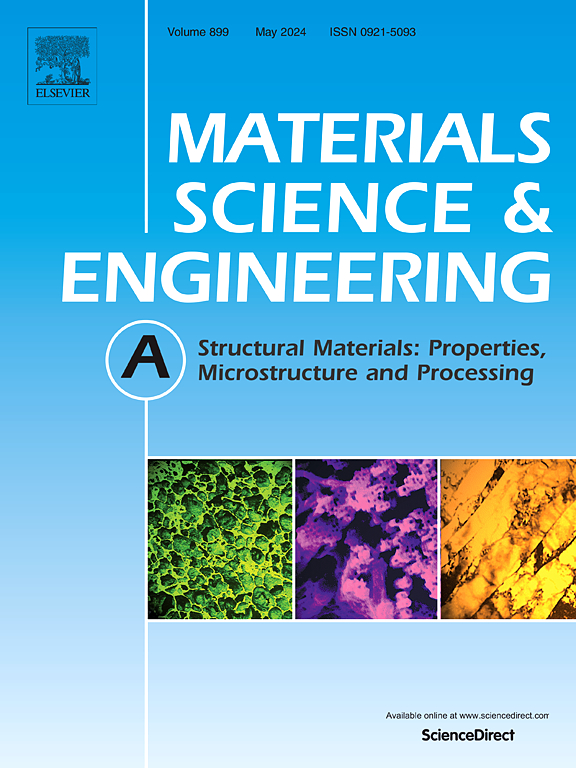Improving mechanical properties of an Al-Zn-Mg-Cu alloy during high stress creep aging via microalloying with Yb
IF 7
2区 材料科学
Q1 MATERIALS SCIENCE, MULTIDISCIPLINARY
引用次数: 0
Abstract
The performance of traditional Al-Zn-Mg-Cu alloys degrades rapidly under high stress, resulting in insufficient creep aging time and inadequate creep strain. A combination of electron and atomic microscopy characterization, along with first-principles calculations, was used to investigate the effect of Yb on the creep aging behavior and mechanical properties of Al-Zn-Mg-Cu alloys under high stress. The mechanism by which Yb extends the creep aging window was elucidated. First-principles calculations revealed that Yb tends to replace Al2 atoms in the η′ phase and Mg atoms in the η phase, raising the formation energies of η′ and η phases and inhibiting the coarsening of the precipitates. A trace addition of 0.3 wt% Yb induces a new primary phase of Al3(Yb, Zr), and further refine the grain size to 30.48 ± 2.3 μm. Under high-stress creep aging, the peak strength of 0.3 Yb alloy was achieved at 4 h, with a yield strength of 667.7 MPa. The yield strength of 0.3 Yb alloy remained stable, maintaining 628.2 MPa even after aging time of 8 h. The addition of Yb extended the high-stress peak aging time from 2 h to 4 h, prolonging the peak aging time. The 0.3 Yb alloy exhibited a "2–8 h aging strengthening peak region," demonstrating better performance stability, reduced fluctuation, and a yield strength above 600 MPa. This contrasts with the Yb-free alloy, which only showed a transient peak aging region (2 h). The addition of Yb effectively increased the formation energies of the η′ and η phases, suppressed the coarsening of the η′ to η phase, and extended the process window for the synergy of creep strain and aging precipitation.
Yb微合金化改善Al-Zn-Mg-Cu合金高应力蠕变时效力学性能
传统的Al-Zn-Mg-Cu合金在高应力作用下,由于蠕变时效时间不足和蠕变应变不足,性能退化迅速。结合电子显微镜和原子显微镜表征,以及第一性原理计算,研究了Yb对高应力下Al-Zn-Mg-Cu合金蠕变时效行为和力学性能的影响。阐明了Yb延长蠕变时效窗口的机理。第一性原理计算表明,Yb倾向于取代η相中的Al2原子和η相中的Mg原子,提高η相和η相的形成能,抑制析出相的粗化。微量添加0.3 wt%的Yb可诱导Al3(Yb, Zr)初生相形成,晶粒细化至30.48±2.3 μm。在高应力蠕变时效下,0.3 Yb合金在时效4 h时达到峰值强度,屈服强度为667.7 MPa。在时效8 h后,0.3 Yb合金的屈服强度保持稳定,仍保持628.2 MPa。Yb的加入将高应力峰值时效时间从2 h延长至4 h,延长了峰值时效时间。0.3 Yb合金表现出“2-8 h时效强化峰区”,性能稳定性好,波动小,屈服强度在600 MPa以上。这与不含yb的合金形成了鲜明对比,后者只出现了一个瞬态峰值时效区(2h)。Yb的加入有效地提高了η相和η相的形成能,抑制了η相向η相的粗化,延长了蠕变应变和时效析出协同作用的过程窗口。
本文章由计算机程序翻译,如有差异,请以英文原文为准。
求助全文
约1分钟内获得全文
求助全文
来源期刊

Materials Science and Engineering: A
工程技术-材料科学:综合
CiteScore
11.50
自引率
15.60%
发文量
1811
审稿时长
31 days
期刊介绍:
Materials Science and Engineering A provides an international medium for the publication of theoretical and experimental studies related to the load-bearing capacity of materials as influenced by their basic properties, processing history, microstructure and operating environment. Appropriate submissions to Materials Science and Engineering A should include scientific and/or engineering factors which affect the microstructure - strength relationships of materials and report the changes to mechanical behavior.
 求助内容:
求助内容: 应助结果提醒方式:
应助结果提醒方式:


